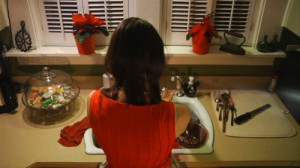The Art of Life: Cinema Verité and Melodrama Rendez-Vous in Robert Greene’s Actress
 Now in its eleventh year, Columbia, Missouri’s True/False Film Festival is rapidly becoming a major stop on the North American festival circuit. Focusing on documentary films, True/False openly embraces films that play with the distinction between fiction and non-fiction. This year, one of the festival’s standouts was the premiere of Actress, the third feature from Robert Greene.
Now in its eleventh year, Columbia, Missouri’s True/False Film Festival is rapidly becoming a major stop on the North American festival circuit. Focusing on documentary films, True/False openly embraces films that play with the distinction between fiction and non-fiction. This year, one of the festival’s standouts was the premiere of Actress, the third feature from Robert Greene.
If you have watched The Wire, you know her face—angular jaw, wide-set eyes, sleek dark hair. Brandy Burre plays Theresa D’Agostino, Tommy Carcetti’s political consultant and Jimmy McNulty’s hook-up partner, in a fifteen-episode arc during seasons 3 and 4. After her stint on the show, Burre went on hiatus to raise her two young children with boyfriend Tim in the quaint town of Beacon, New York. When she decided to reenter showbiz, her friend and neighbor, documentary filmmaker Robert Greene, was on hand to capture the process. At the beginning of the 18-month-long shoot, Greene did not realize that he would document both the rebirth of Burre’s career and the end of her romantic partnership.
The film opens with a shot of Burre from behind, washing dishes. Dressed in a bright red dress and flanked on either side by pots of crimson flowers, lit by spotlights that fall off into darkness, she seems to be on a theater stage, in a kitchen meant to evoke mid-century motherhood and all its attendant strains. While holding a glass, she speaks in voiceover about being the kind of person “who breaks things.” Then the film switches into a cinema verité register with the muted colors of digital video, and it becomes clear that this stage set was Burre and Tim’s kitchen all along. Greene had cast Burre in a scene from a Sirk-ean melodrama, staged in her own home.
A documentary filmmaker explicitly interested in questions of performance (his most recent feature, Fake It So Real, focuses on independent pro wrestling), Greene uses Burre’s personal life upheaval “to get at the theatricality of performing yourself, the theatricality of everyday life and how we can make melodramas in our heads.” The majority of Actress is direct cinema-style depictions of Burre’s daily life—handing her children juiceboxes from the fridge, rolling up a porch rug in advance of an impending blizzard, driving to New York City to sing at a cabaret—and interviews in which Burre speaks directly to the camera, explaining her thought processes and emotional logic. While these scenes of humdrum life and clarifying confessionals have a potency all their own, they take on more affecting power when combined with the occasional stylized sequence, some of which blend more seamlessly with the narrative than the brilliantly-lit kitchen scene.
Specifically, a few bravura slow-motion shots, combined with haunting music, make the melodrama of Burre’s life come even more into focus. After watching a video of her daughter’s birthday party in California, celebrated while Burre stayed in New York for a singing gig, Burre weeps. In the next shot, its temporal relationship to the former uncertain, the camera follows Burre in slow motion as she checks on food she is cooking on the stove, then walks through a dark room to the foyer. Her young daughter stands on the staircase, waving a clothes hanger, which Burre takes, holding it in one hand and throwing her head back as if accepting a trophy. Harry Belafonte’s sweet, mournful version of “Waly Waly” (also known as “False Love”) plays throughout this slow-motion shot, imbuing the mother and daughter’s simple gestures with poignancy and emphasizing Burre’s emotional turmoil over the break-up of her family.
The filmmaker’s techniques serve to draw attention to the constructed nature of the film and to emphasize the internally dramatic quality of Burre’s ostensibly ordinary life. Thus, the film both expands the nature of documentary filmmaking (alongside other formally inventive and metacritical recent documentaries such as Stories We Tell and The Act of Killing), and expands the acceptable limits of life melodrama. Rather than cling to the notion that cinema verite’s objectivity is the path to truth, Greene uses a cinema verité style to both show the external reality of Burre’s daily life, and to express her personal, subjective experience of it.
In addition to directing, Greene is also an accomplished editor, having cut recent documentaries Owning the Weather and Making the Boys. While in some ways Actress resembles personal documentaries made by Miriam Weinstein, Ed Pincus, and Ross McElwee, Greene also draws on his experience editing fiction films, such as indie director Alex Ross Perry’s forthcoming Listen Up Philip. As such, it is not so odd that Greene points to inspiration in a specific genre of fiction filmmaking: the musical. Writing for Sight & Sound in January 2014, Greene explains why he rewatches Mary Poppins every time he begins editing a film. He writes, “Musicals have similar narrative/non-narrative tensions [as documentary films] and the best movies artfully exploit this to create unique viewing experiences. …The narrative arrangements are similarly broad, fluid and nontraditional and exploring the way musicals propel stories forward with set pieces, layered meanings and use of expressionistic imagery can be highly instructive.” One hopes current and future non-fiction filmmakers are listening.
Actress is an Opening Night Selection at the Wisconsin Film Festival. Director Robert Greene and star Brandy Burre will be in attendance.



[…] Amazing piece about ACTRESS on the Antenna blog! […]
[…] Robert news, dig the rave reviews he’s been receiving for his latest film, Actress, here and here. Actress, will screen as part of Lincoln Center’s, Art of the Real film series in […]